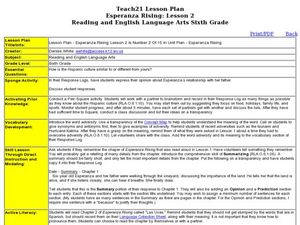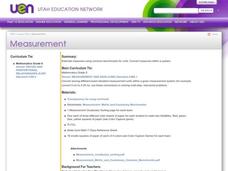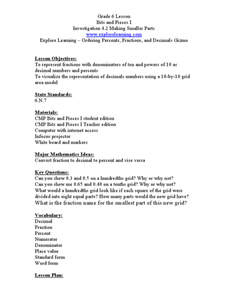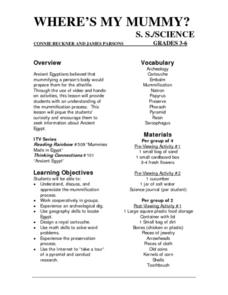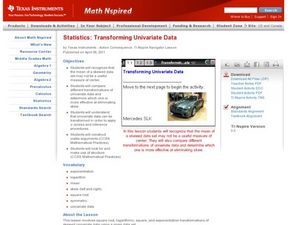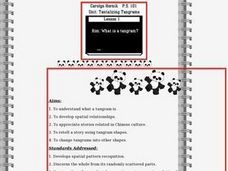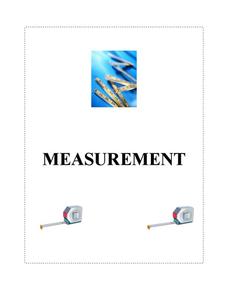Curated OER
Out of the Dust--Appeals to Senses
Young scholars list examples of appeals to the senses in the poem Out of the Dust. In this Out of the Dust lesson plan, students discuss ways that the author brings the story alive through appeals to the senses. Young scholars discuss...
Curated OER
Esperanza Rising: Lesson 2
Sixth graders explore adversity. In this summarizing lesson students compare their culture to the Hispanic culture. Students reflect on a time they were met with adversity. Students summarize Chapter 1 of Esperanza Rising.
Curated OER
Worksheet 6: Reading: Recipe for Beignets
Travel to New Orleans for their warm, sweet beignets, or bring a piece of New Orleans to your classroom by baking the delicious treats with your third and fourth graders! If baking them isn't possible, at least review the recipe for a...
Curated OER
Measurement
Students explore the concept of measurement. In this measurement instructional activity, students discuss what specific measurement tools such as an odometer measure. Students recite a measurement poem. Students make a foldable with...
Curated OER
Bits and Pieces I
Sixth graders examine making smaller parts out of fractions and decimals. In this online interactive fractions, decimals, and percents lesson plan, 6th graders represent fractions with denominators of ten. Students then represent powers...
Curated OER
A Practical Application For Area
First graders investigate the concept of surface area and find the coverage for the surfaces in a building that includes carpet or walls. The application of finding the area is practical using the everyday objects to help them to make...
Curated OER
Where's My Mummy: Preservation Techniques
To observe preservation techniques firsthand, learners dry a flower in sand and compare cucumber slices soaked in salt water for a week with slices left out to dry in the open air. Video resources (not attached) include one about mummies...
Curated OER
The Family Quilt
Third graders examine the artwork of Faith Ringgold. They create their own quilt pattern on fabric and piece them together to create a class quilt. They compare their similarities with one another.
Curated OER
Investigation - Representing Place Value
Third graders demonstrate models to represent a 3 digit counting number. They use manipulative materials to represent place value in whole numbers. Students represent numbers in expanded notation.
Curated OER
Activities with 3-D shapes.
In this 3D shapes activity, students describe faces, feel shapes in a bag, use play dough to make shapes, and more. Students complete 8 activities.
Curated OER
Transforming Univariate Data
Learners analyze plotted data in this statistics lesson. They differentiate between skewed and normal data. They also explore and interconnect exponential growth and decay as it relates to the data.
Curated OER
What is a Tangram?
Students identify a tangram. In this geometry activity, students read Grandfather Tang's Story and retell each story using the tangrams on a flannel board. Students use tangrams to complete an included worksheet.
Curated OER
What Does Average Look Like?
Fifth graders explore the concepts of range, median, mode, and mean through the use of graphs drawn from models. They use manipulatives to represent data they have collected within their groups, and compare the differences between mode,...
Curated OER
Push or Pull
Young scholars discover that one way to change how something is moving is to give it a push or a pull. They design their own boats and work with 'The Great Boat Push' worksheet to compare how their boats move when they are pushed or...
Curated OER
Polar Bear Panic!
Students identify the three realms of the Arctic Ocean, and describe the relationships between these realms. They graphically analyze data on sea ice cover in the Arctic Ocean, and recognize a trend in these data.
Curated OER
Framing the Landscape
Students draw their own drawings after learning about composition of drawings and lines. In this drawing lesson plan, students learn about different lines they can use while drawing. Then they go outside and draw their own.
Curated OER
Calculating Baseball Statistics
Students calculate baseball statistics. In this data analysis lesson, students use baseball statistics to calculate the batting average and slugging percentage. Students visit www.funbrain.com to play a math baseball game.
Curated OER
Comparing Cultural Holidays
Third graders explore art that reflects their cultural background. For this writing and research lesson students compare and contrast the Halloween with El Dia de los Muertos. Students study the visual art of these holidays. Then...
Curated OER
Filling in the Picture
Young scholars study archaeological sites. They discover some of the problems inherent in choosing sites and what parts are chosen for excavation. They evaluate and explain their choices for study and articulate the process of...
Curated OER
Topography of Africa
Students study Africa's diverse landscape and investigate how these features impact the available water supply, food sources, and population distribution of the continent. They compare topographical features and
their affect on each...
Curated OER
Measurement
Students identify and categorize different problem situations or contexts using one of four measurements to solve the problem. Through guided and independent practice, they discover ways to determine which measurement to use when...
Curated OER
Concrete Research
Students explore concrete. In this physical science and computer research instructional activity, students work in groups to answer specific questions about concrete. Each group of students completes a different worksheet with a...
Curated OER
Weather, Sea Level Rise and Climate Change Course
Students explain the impact of glacial melting to global climate change. In this environmental science lesson, students design an experiment to investigate the effect of salinity change to melting glaciers. They share their results to...
Curated OER
Prime and Composite Numbers with use of manipulatives (Elementary, Mathematics)
Students learn what prime and composite numbers are. They learn how to identify them by working in a group and demonstrating an understanding of one work problem with 100% accuracy using the manipulatives provided.



